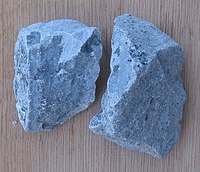This is an old revision of this page, as edited by Draicone (talk | contribs) at 12:58, 29 June 2006 (→Methides: Reactions with other substances too...). The present address (URL) is a permanent link to this revision, which may differ significantly from the current revision.
Revision as of 12:58, 29 June 2006 by Draicone (talk | contribs) (→Methides: Reactions with other substances too...)(diff) ← Previous revision | Latest revision (diff) | Newer revision → (diff)
In chemistry, Carbide confusingly refers to three different things:
1. The polyatomic ion C2, or any salt of such. There is a triple covalent bond between the two carbon atoms.
2. The monatomic ion C, or any salt of such. This ion is a very strong base, and will combine with four protons to form methane: C + 4 H → CH4.
3. A carbon-containing alloy or doping of a metal or semiconductor, such as steel.
Examples
- Sodium carbide (Na2C2)
- Silicon carbide (SiC)
- Tungsten carbide (often called simply carbide)
- Cementite (iron carbide; Fe3C)
See Category:Carbides for a bigger list.
Types of carbides
Methides
A salt corresponding to the ion C can be called a methide. Methides commonly react with water to form methane, however reactions with other substances are common.
Acetylides
A salt corresponding to the ion C2 can be called an acetylide. Acetylides commonly react with water to form acetylene.
Compounds that do not fit usual notions of valence or stoichiometry
Interstitial carbides
These are formed with metals; they often have metallic properties.
Some covalent compounds
Elements that have similar electronegativity form mainly covalent compounds. For example, the compound silicon carbide is mostly covalent; it has similar structure to diamond.
Properties
Under conditions of standard temperature and pressure, metal carbides react strongly with water to form metal oxides or hydroxides and flammable acetylene gas, e.g.:
- CaC2 + 2H2O → C2H2 + Ca(OH)2
Carbide lamps, an important source of portable subterranean illumination for mining and caving, and in the past for lighthouse lamps, work through on-demand production and combustion of acetylene by the metered addition of water to calcium carbide.
Gas lighting, using acetylene gas generated from carbide, was used in some homes before the incandescent lamp came into widespread use. It was also the main source of lighting on bicycles and carriages before the widespread availability of electric lamps and batteries. The carbide was prepared industrially by the action of an electric arc furnace on a mixture of coke and limestone.
In the northern, eastern and southern regions of the Netherlands and in Belgium carbide is used as fireworks. To create an explosion, carbide and water are put in a milk churn with a lid. Ignition is usually done with a torch. Some villages in the Netherlands fire multiple milk churns in a row as an oldyear tradition.